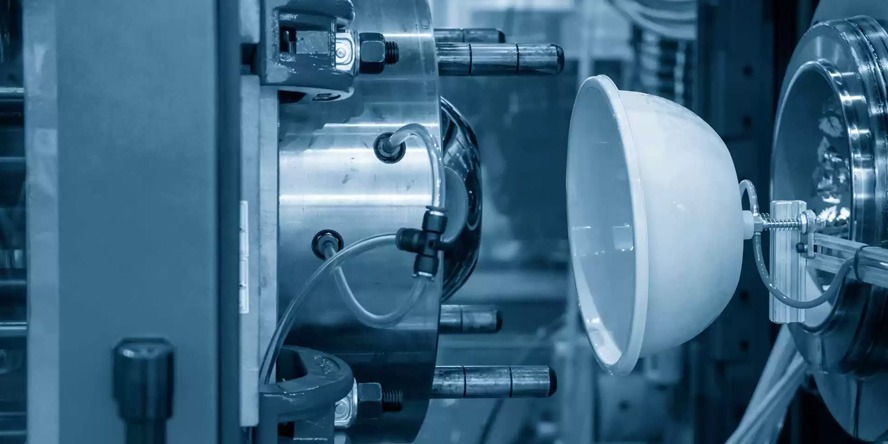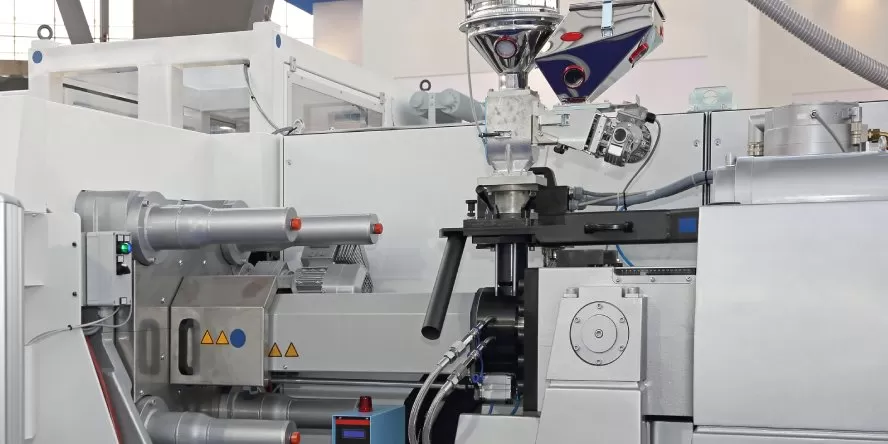Fire protection in the machine park required intensive work, highly focused technical support and, above all, listening carefully to the client’s needs. The goal was to deliver a solution fully tailored to their requirements, providing complete protection for both the process equipment and the safety of employees.
Problem
- Securing a machine park of injection moulding machines and extruders
- Need for an automated solution integrated with existing production line systems and safety devices
- No off-the-shelf solution available on the marke
Solution
- We developed a customised solution
- The system meets all customer requirements
The automatic extinguishing system activates in under 1 second from fire-risk detection
Continuous Work on Improving Safety
At one of the leading manufacturers in the plastics processing industry, the safety of people, processes and technology has always been a priority. Due to the dynamic nature of operations and ongoing company growth, system upgrades are carried out on a continuous basis as new needs arise. One such need was identified by the insurer, who pointed out areas where fire hazards could be addressed even more effectively by enhancing the existing solutions.
Requirement: An Immediate-Response System Independent of the Operator
The insurance company suggested nhancing the existing fire-detection systems installed on the injection moulding machines and extruders. Looking for a highly automated and reliable solution, the client contacted WOLFF GROUP engineers. From the outset, integration with machine automation systems, the existing DCS and the fire alarm system (SSP) was also required.
During the discussions, we identified an additional need: to minimise operator involvement in the safety system’s operation. The objective was to ensure the fastest possible — almost instantaneous — response in emergency situations.
Fire Hazard That Can Destroy Machinery and the Plant
Production in facilities using injection moulding machines and extruders involves a real risk of ignition, especially in areas with high temperatures, pressure and hydraulic oils. If the recommended processing temperature of the plastic is exceeded, the material can start to decompose and release flammable gases.

A Multi-Stage Implementation Process
The implementation process resulted from close cooperation between our engineers and a dedicated team on the client’s side – from initial discussions, through concept development and functional tests, to full implementation and configuration of the operational and alarm logic. Our goal was not only to deliver the system, but primarily to understand the client’s core requirement: to ensure that their production lines are protected in an intelligent, fast and reliable way.
Automatic machine shutdown and decompression in under 1 second from ignition-risk detection
Awareness of these risks and potential losses led to the idea of creating a system that not only detects a threat, but reacts faster than any operator – automatically shutting down and decompressing the machines when a fire risk is detected.
Reaction time had to be reduced to an absolute minimum. To prevent the fire from spreading, sensors needed to be linked to a control unit connected to the machine control system, so that production would stop immediately after detecting an ignition source. This required developing software to integrate the control unit with the machine automation and control systems.
Previous solutions: standard smoke detectors proved insufficient
The injection moulding machines and extruders to be protected came from several manufacturers. Fire protection relied mainly on a conventional hall-wide detection system. However, the company realised that a standard detection system was no longer sufficient — a solution was needed that would protect each machine individually, operate in real time and remain resistant to the demanding industrial environment.
Problem: Lack of System Solutions on the Market
There are currently no ready-made system solutions on the market that fully meet this type of requirement. It is therefore not possible to simply purchase and install a suitable safety system. This made it necessary for our engineers to go beyond standard approaches and known solutions.
Initial Stage: Understanding the Investor’s Key Requirements
To ensure that the system would operate in line with the agreed assumptions, our engineers needed more than knowledge of available protection measures and their limitations. Practical experience in securing industrial facilities, machines and production lines against fire was essential. The solution had to meet a number of practical requirements defined by the investor for the safety systems to be delivered.
Requirement 1: Environmental Resistance
One of the investor’s key requirements was to deliver a system that could withstand harsh industrial conditions. Due to the environment in which the machines operate, the protection systems had to be resistant to high temperatures, dust generated during the production process, and potential damage or hydraulic oil leaks.
Requirement 2: Integration with the Existing Safety Infrastructure (SSP and DCS)
Because the client was already using safety infrastructure, including a fire alarm system (SSP) and a DCS, the new solution had to be fully integrated with both. The system was therefore required not only to detect a hazard, stop the machine and perform decompression, but also to communicate the event appropriately. This required precise programming and thorough testing.
Requirement 3: Individual System Calibration to the Technology and Production Process
Each industry has its own specific characteristics, particularly in terms of the machinery and equipment used. The planned integration therefore had to allow for individual calibration, with parameters tailored to the client’s technology and production setup. Aligning all system components could not leave any margin for error, as the safety of the plant and its employees depended on it.

Concept Stage: Joint Risk Analysis and Identification of Critical Points
To create a solution that did not previously exist on the market, we first established a team of engineers responsible for designing the entire installation. The team included WOLFF GROUP specialists, tasked with selecting fire protection measures, and selected employees from the client’s organisation who had in-depth knowledge of the machine mechanics and technologies used on site. The insights they shared enabled us to understand how the production line operates and what the client’s key needs were.
It was also essential to identify the critical points with the highest risk so that suitable technical protection measures could be selected. Based on this, we developed a concept built on a specialised pyrometric detection system supported by custom-developed software. The concept was then presented to the investor and their insurer for approval.
Selection of Core Technology
Individually selected pyrometric detection system – real-time temperature monitoring
A specialised, individually selected pyrometric detection system was chosen to detect rising temperatures or early ignition points. Its continuous operation enables real-time monitoring of the temperature of the machines and production lines. This allows the system to activate at a very early stage of a developing hazard.
Addressable Fire Alarm System
To connect the sensors to the existing alarm systems and ensure automatic machine shutdown, it was necessary to select a suitable control panel. It had to be flexible enough to allow equipment configuration, instant response, selection of the required functions and scalability for future expansion — all within a single device.
Integration via I/O Modules with Supervisory (Shutdown) Systems
With the appropriate modules, we linked the detection systems to the control and alarm systems. These modules enabled the implementation of the dedicated software we developed.
Automatic Control of the Shutdown and Decompression Procedure for Injection Moulding Machines
To prevent pressure build-up from damaging machine components, the system also had to be integrated with the decompression functions. The decompression method depended on the machine type, its technical parameters and the manufacturer’s recommendations. As demanded by the investor, decompression had to start immediately after the machine was stopped, which required dedicated automation programming for each injection moulding machine model.
Implementation stage: Integrating the technologies into one coherent system
Designing detectors for the specifics of thermal processes
Plastics forming involves thermal processing. Understanding temperature ranges in each stage allowed us to programme the detectors to identify abnormal changes — especially temperature rises characteristic of an emerging fire.
On site, we also tested detector positioning to determine the optimal installation layout. This stage was critical. Due to the structural differences between injection moulding machine models, the detection components had to be positioned to monitor the designated areas without interfering with nearby machinery.
Next, we connected the detection system to a selected fire alarm control panel. This centralised all monitoring points, enabling standardised control. We ensured loop communication and full integration of alarms with the supervisory system. As a result, any irregularity — from heater overheating to flame detection — is immediately transmitted to both the technical services team and the plant’s safety management system.
Programming the control logic and testing <1 s reaction time
Because the system was tailored specifically for the client, the key challenge was to synchronise all components perfectly. We continuously calibrated the software and detectors to collect data on standard temperature ranges and deviations – separately for each machine. The goal was to achieve the shortest possible detector response time, enabling the control panel to automatically stop the running process and activate machine decompression.
Integration with Machine Automation
The final stage was the integration with the automation of the protected injection moulding machines. In cooperation with the client’s engineers and in-house specialists, this process was efficiently completed using dedicated software developed for this purpose.
A key phase involved testing the system in a non-alarm mode. This allowed us to carry out final calibration and eliminate the risk of false alarms or incorrect readings once the system went live.
After completing the tests, the system was configured to trigger the shutdown and decompression procedure in under one second – before a fire has the chance to develop.
Implementation, training of technical staff, post-implementation support
After all modifications were completed, the final step was to train the plant personnel. We prepared dedicated training to show how to work effectively with the new technology. This post-implementation support enabled employees to understand the system’s operating specifics and the changes required in maintenance and servicing procedures.
Achieved Results
The client’s facility now operates an integrated protection system that not only responds automatically, but also continuously analyses operating parameters to minimise the risk of downtime and damage. This project demonstrates that safety and technology can go hand in hand. Automation can increase efficiency while protecting what matters most: people, processes and technology.
Immediate response — shutdown and decompression in <1 s
The system has proven effective not only during testing, but also in real operation on the protected machines.
Full alarm integration (SSP + DCS)
To maintain one coherent system, the entire installation was integrated so that detection and alarm functions work together with machine control, simplifying production line operation.
Integration with machine automation
Proper integration enabled automatic process shutdown, preventing fire from spreading.
Increased safety for people, equipment and processes
The system’s speed and effectiveness prevent the ignition and spread of fire, significantly strengthening safety.
Possibility of future expansion with extinguishing systems
Using a fire-protection control panel not only enabled integration of all key system components, but also allows future expansion with additional extinguishing systems.
Reduced risk of downtime and emergency costs
Early detection, automatic machine shutdown and decompression reduced the risk of downtime caused by damage to injection moulding machines or extruders.




